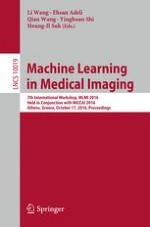2016 | OriginalPaper | Buchkapitel
Deep Ensemble Sparse Regression Network for Alzheimer’s Disease Diagnosis
verfasst von : Heung-Il Suk, Dinggang Shen
Erschienen in: Machine Learning in Medical Imaging
Aktivieren Sie unsere intelligente Suche, um passende Fachinhalte oder Patente zu finden.
Wählen Sie Textabschnitte aus um mit Künstlicher Intelligenz passenden Patente zu finden. powered by
Markieren Sie Textabschnitte, um KI-gestützt weitere passende Inhalte zu finden. powered by
